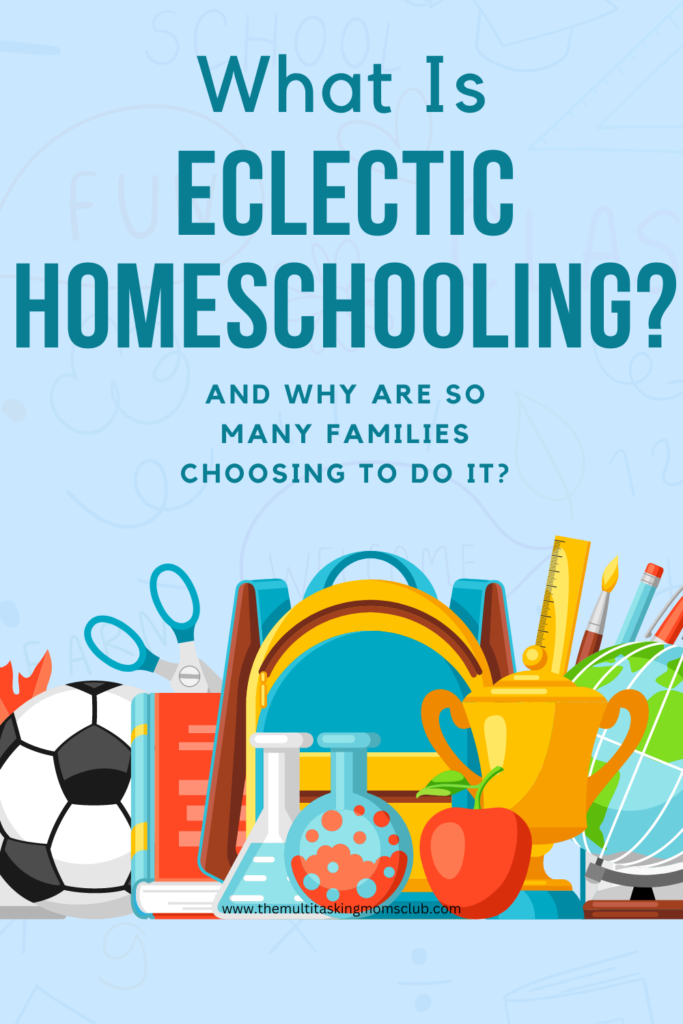If you are new to the wonderful world of homeschooling, you may have heard the term “eclectic homeschooling”. But, what is it? And why are so many families choosing eclectic homeschooling as their preferred method?

A Very, Very Brief Overview of Homeschool Methods
As you may know, homeschoolers use different methods, or philosophies of education, in their homeschools. For example:
Charlotte Mason Method – Uses living books as textbooks, schedules short lessons (15 minutes or so) in the elementary level, is heavy on narration (the student repeats what they have read or heard using their own words), often utilizes nature notebooking (drawing pictures of things found in nature).
Classical Education Method – Bases scope and sequence on the Trivium, the idea that brains develop in different stages, thus are better able to learn different things at the different stages. The stages are grammar, logic, and rhetoric (roughly elementary, middle, and high school ages). In classical education, knowledge learning is best in the grammar stage, understanding in the logic stage, and wisdom in the rhetoric stage.
Online School – Another popular method of homeschooling utilizes online schooling. In some cases, this can mean public school at home, or an independent private school.
Unschooling – This method allows the child’s interests to drive their learning. The belief is that kids will learn what they need to know, when they want to know it. For example, a child might not have any interest in reading when they are 5, but when they do suddenly want to learn to read when they are 8, they will learn faster.
Unit Studies – Unit studies base all subject lessons around a particular theme. If the child is interested in Ancient Egypt, their unit study might include the science of Nile flooding, literature from/or about the time period, history of the pharoahs, and the math needed to build the pyramids.
Montessori – Based on the work of Maria Montessori, this education method uses interest-based lesson plans with lots of free time (often to play with manipulatives). One of the main ideas is that learning happens through play, especially playing with educational toys.
So What Is Eclectic Homeschooling?
Eclectic homeschooling is arguably the most popular method of homeschooling… and I totally say that anecdotally. I’m not sure of any formal study or statistics that prove my hypothesis. 🙂
Nonetheless, once you read up on and understand all the different homeschooling methods, it becomes tough to pick just one. All of the above mentioned methods have something great to offer, so how do you decide on just one?
Well, many of us don’t decide to use just one. We combine the best elements of each to fit each of our children. THAT is what “eclectic homeschooling” means. It’s combining many elements of some or all of the homeschooling styles.
Now that you know what eclectic homeschooling is, let’s create a sample eclectic education for a ficticious 6th grader.
Our student here is obsessed with roller coasters, staying glued to YouTube watching videos of people who have built roller coasters in their own backyards
. Mom creates a unit study on roller coasters that includes math lessons based on the expenses of building a coaster, the physics of how coasters work, and history lessons on the development of roller coasters over time.
The student embarks on building a small coaster in the backyard. This can be seen as unschooling, since this is an interest-based project. This might even fall under Montessori, since huge chunks of time are used to work with manipulatives (wood, screws, etc.).
But, mom still feels like this is a bit weak on learning, so she decides to enroll the student in an online Math class to make sure they don’t get behind as they prepare for high school.
Beyond just the history of roller coasters, mom also decides to have the student read some living history books about Coney Island (since there is a roller coaster there!) and the growth of New York during the late 1800s to early 1900s. The living books are a great example of Charlotte Mason education.
Mom continues to utilize the science class at the local co-op that is based on the 4 year cycle of learning based on the Classical education model. Year 1 is Biology, year 2 is Earth Science, year 3 is Chemistry, year 4 is Physics. This 4-year cycle is repeated three times from 1st-12th grade. Since our student is in 6th grade, they are studying Earth Science for the logic stage.
Final Thoughts
Once you research and learn about the different educational methods for homeschooling, it is so difficult to commit to just one. If you are using an all-in-one curriculum, but are looking to branch out a bit, throw in a unit study just on Fridays. Maybe you can add nature walks with nature journaling to your homeschool plans. If your kids are on the computer all day, make time for them to build or create something to get them exposed to tactile learning.
Eclectic learning will look different for every family, sometimes even every kid within the family. THAT is the beauty of eclectic homeschooling!
